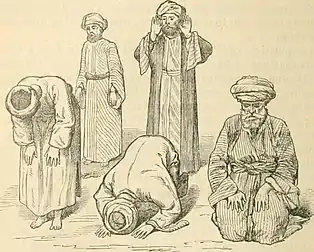Rakat
A rakaʿah (Arabic: ركعة rakʿah, pronounced [ˈrakʕah]; plural: ركعات rakaʿāt), is a single iteration of prescribed movements and supplications performed by Muslims as part of the prescribed ritual prayer known as salaa. Each of the five daily prayers observed by Muslims consists of a number of raka'ahs.
| Part of a series on |
| Islamic jurisprudence (fiqh) |
|---|
 |
| Islamic studies |

Procedure
After washing for prayer by performing the ritual ablution, a believer must renew their innermost intention, thus purifying their prayer for sake of Allah (Arabic: الله Allah, pronounced [allāh]).
The raka'ah begins when the worshipper initiates the prayer with the words "Allah is The Greatest", this is known in Arabic as the Takbeer (Literally: The Glorification of God). The individual will observe the standing position while reciting the opening chapter of the Qur'an (Al-Faatiha) followed by a personal selection of chosen verses which the worshipper is free to choose to recite for themselves.
The second part of the raka'ah involves the worshipper bowing to a 90 degree angle placing their hands on knees with their feet kept shoulder-width apart bowing in humble submission as if awaiting God's command. During this position the words, "Glory be to Allah the Most Magnificent" are uttered silently as a form of ritual praise.
The third movement of the raka'ah is to return from bowing to the standing position before, with the praise of Allah on your tongue, descending into full prostration on the ground.
In prostration your forehead and nose should be flatly placed on the floor with the palm of your hands placed shoulder-width apart to the right and left of your ears. Your elbows, forearms and chest should be raised off the floor in an alert position in total but conscious submission to Allah.
During this position the words, "Glory be to Allah the Almighty" are repeated with contemplation as a form of ritual praise. The Islamic prophet prophet Muhammad taught his disciples that 'the closest a subject gets their Lord is when in prostration', as such he taught us to open our hearts in supplication seeking guidance, sustenance, forgiveness for our sins, a cure for our ailments, alleviation of our difficulties invoking His mercy and compassion in the name of Almighty Allah alone.
The fourth movement is to return from prostration into a sitting position with your legs folded flatly under your body. In this position you would invoke Allah for forgiveness of your sins and the sins of your parents and the wider believers before descending into a second prostration.
This concludes one unit of prayer known in Arabic as a raka'ah and would be followed by either standing up for a second raka'ah if the prayer requires it or by proceeding to end the salaa with tasleem.
Although not part of a single raka'ah, the conclusion of the prayer takes place in the sitting position, the worshipper turns their head to the right saying, "Peace be unto you, and Allah's mercy and blessing" before subsequently turning the head to the left and repeating the salutation. This action helps to reminds Muslims of the presence of the recording angels on his right and left who record our deeds. [1]
Daily Prayer Rakʿah
Each daily prayer has a different number of Rakah:
- Fajr — The Dawn prayer: 2 Rakat Sunnah + 2 Rakat Fard
- Zuhr — The Midday or Afternoon Prayer: 4 Rakat Sunnat + 4 Rakat Fard + 2 Rakat Sunnah followed by 2 Rakat Nafl
- Asr — The Evening Prayer: 4 Rakat Sunnah + 4 Rakat Fard
- Maghrib — The Dusk Prayer: 3 Rakat Fard + 2 Rakat Sunnah followed by 2 Rakat Nafl
- Isha — The Night Prayer: 4 Rakat Sunnah + 4 Rakat Fard + 2 Rakat Sunnah +2 rakat Nafl + 3 Rakat Witr and 2 Rakat Nafl before and after the Witr.
Regarding Jumu'ah (Friday) Prayer.[lower-alpha 1] It consists of 2 Rakat mandatory Sunnah before the Arabic Khutbah and followed by 4 Rakat Sunnah[lower-alpha 2] after the 2 Fard Rakat and then 2 Rakat Sunnah and 2 Rakat Nafl. There are two Eid prayers in a year, Eid-ul-fitr and Eid-ul-adha.
See also
Notes
- Only performed in the first rakat of the prayer and only performed by some schools.
- Only first half of the Tashahhud is recited in the second rakat in a 4- or 3-rakat prayer, e.g. the afternoon prayer or the evening prayer, but all of it is recited in the last rakat of any prayer.
- Only performed in the last rakat of a prayer.
Endnotes
- Friday prayer is prayed in ijma‘ only in the mosque on Fridays instead of Zuhur prayer
- Prophet Muhammad used to offer 2 + 2 rakaah in mosque or only 2 rakaah at home
